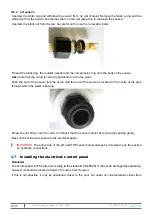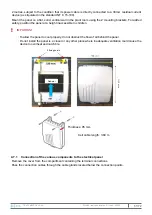
2019/08 - Indice de révision : D - Code : 29650
TRAITEMENT DE L'EAU
55/72
6.
CHLORINE STABILISATION:
The Chlorine introduced into the pool by the electrolysis cell is unstabilised active Chlorine that is easily
destroyed by UV light and heat.
To limit this phenomenon while the pool is uncovered, the addition of a Chlorine stabiliser, Isocyanuric
acid (concentration approx. 30 ppm) is recommended.
The Chlorine stabiliser does not break down over time; if the pool was disinfected with Chlorine before
the electrolyser was installed, measure the initial stabiliser concentration before adding any more. Excess
stabiliser (above 75 ppm) will block the action of Chlorine and falsify measurement of the Redox potential.
7.
STARTING THE ELECTROLYSER:
Once the electrolyser is wired in, hydraulic connections have been made, the water parameters have
been adjusted and the salt and stabiliser have been completely dissolved, the device may be switched on.
Upon being energised, the message
OFF
is displayed on the LCD screen.
Press the
ON/OFF
button (7).
If the flow of water past the flow sensor is adequate (> 5 m3/h), the message
ON
(
EES
) or
AUTO
(
EES
Pro
- indicating that production of Chlorine is controlled by the pH and Redox sensors) is displayed at the
bottom of the LCD screen: the device is able to produce Chlorine.
If the message
STD-BY
(stand-by) is shown, the filtration timer is not currently at a run cycle: check that
the timer is in Auto mode and wait for the next filtration cycle, or force filtration on by switching the timer
to the I position.
If the timer triggers the filtration pump to run, but the water flow rate is too low (< 3 m3) or there is no flow,
the message
NO FLOW
is displayed. Check the following:
•
the filtration pump is running
•
the pump is properly primed
•
the pump is rotating in the correct direction (in the case of a 3 phase pump)
•
The valves on the by-pass loop are correctly adjusted: the central valve is sufficiently closed and the 2
valves upstream and downstream of the EES electrolyser are sufficiently open;
•
water is flowing in the correct direction past the flow sensor, and the flow sensor has not been mounted
















































